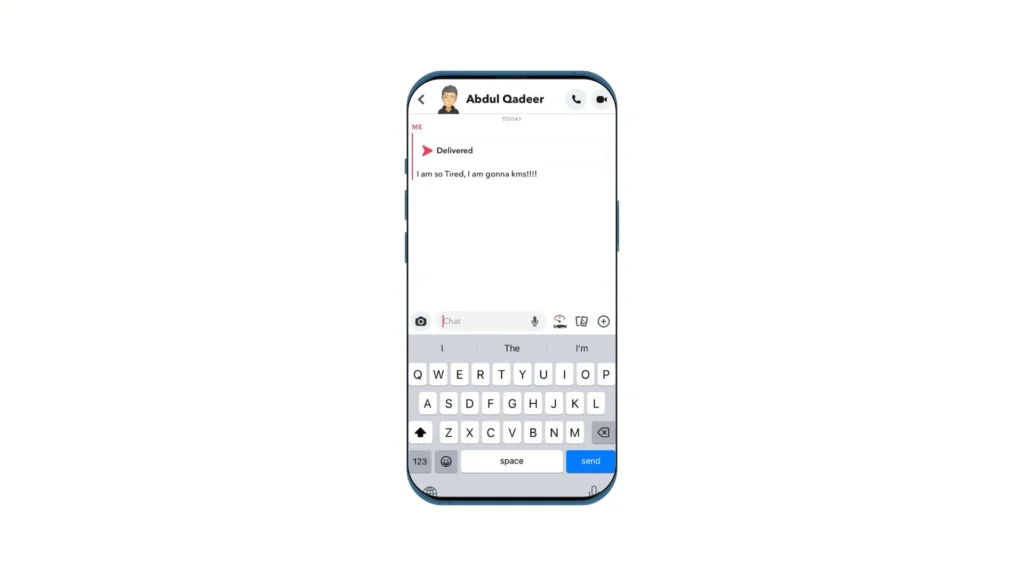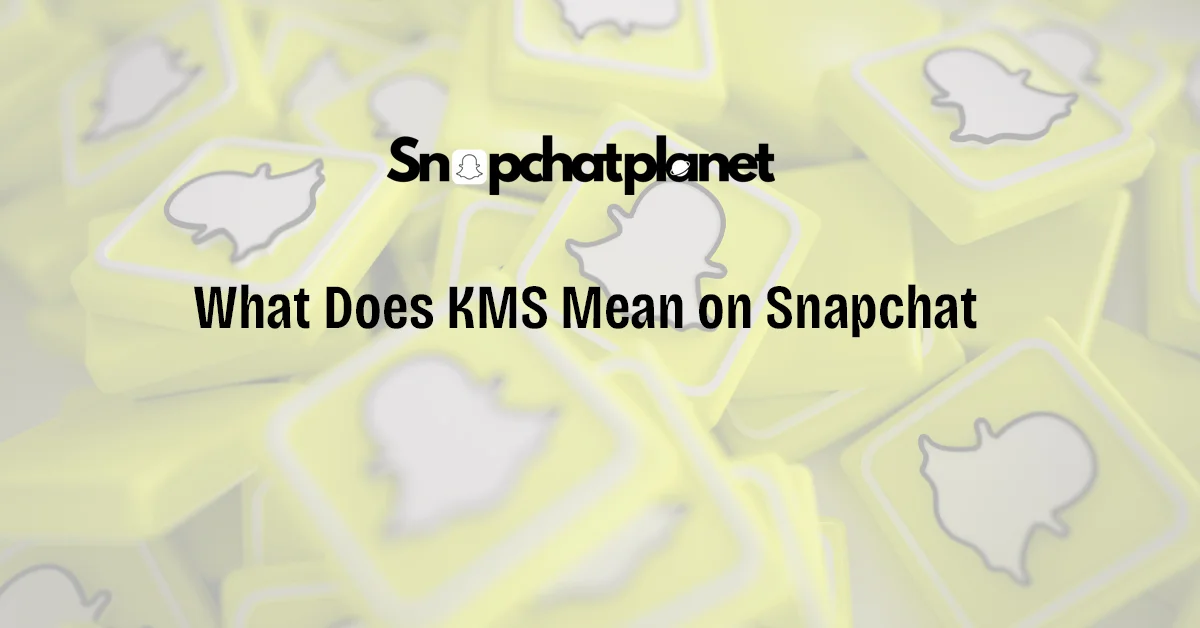“KMS” is a common acronym used on Snapchat and other social media platforms. It stands for “Kill Myself,” but its meaning can vary based on the context. While it can sound alarming, the phrase is often used jokingly or melodramatically by teens and young adults to express frustration or exaggeration about a situation. However, it’s important to know when it’s used in a serious manner to ensure the right response is given.
What is the Meaning of KMS on Snapchat
“Kill Myself” as an Exaggeration
On Snapchat, “KMS” is typically used as a hyperbolic expression when someone is annoyed or frustrated by something minor. It’s not meant to indicate real harm but rather to add dramatic emphasis to an inconvenience or small disappointment. For example, someone might say “I forgot my lunch, KMS” or “I have so much homework, KMS” to express that they’re upset or overwhelmed by the situation, even though they don’t literally mean it.
Serious vs. Melodramatic Usage
In most cases, “KMS” is thrown around casually and without harmful intent. It’s often used between friends who understand the playful, exaggerated tone. However, there are instances where “KMS” could signal real distress. If the tone seems off or it’s coupled with concerning messages about feeling hopeless or down, it’s essential to take it seriously. Knowing the difference between a joke and a cry for help can make all the difference.

Secondary Meaning of KMS
“Killing Me Slowly” in Casual Conversations
Another, less alarming meaning of “KMS” is “Killing Me Slowly.” This version is used when someone wants to express boredom or impatience. For example, if someone is waiting in a long line or watching a dull movie, they might say, “This lecture is killing me slowly, KMS.” It’s a lighthearted way to show they’re not enjoying the current situation but aren’t actually in distress.
How to Respond to KMS on Snapchat
Lighthearted Replies to Sarcastic KMS
When “KMS” is used sarcastically or dramatically, the best way to respond is with humor or empathy that matches the tone. You could respond with something like, “Oh no, don’t worry, we’ll get through this!” or “Hang in there, the day’s almost over!” A playful response acknowledges their frustration without taking the phrase too seriously.
Recognizing Serious KMS and Providing Support
If you sense that someone is using “KMS” in a serious or concerning way, it’s crucial to step in and offer support. Ask them if they’re okay, and encourage them to talk about what’s bothering them. A response like, “Hey, are you doing okay? I’m here if you want to talk,” can open the door for them to share their feelings. If their messages suggest they might be in real emotional pain, it’s important to get them help by reaching out to a trusted adult or professional.
When to Take KMS Seriously
Identifying Warning Signs of Self-Harm or Suicidal Ideations
While “KMS” is often used jokingly on Snapchat, it’s essential to be mindful of the context. If a person frequently talks about feeling hopeless, isolated, or worthless in their messages, it could be a red flag. Accompanying phrases like “I can’t do this anymore” or “I feel so alone” could indicate deeper emotional distress. In such cases, it’s crucial to take their words seriously and provide support. Nonverbal cues, like a shift in their social media activity (e.g., posting dark or concerning content), are also signs they may need help.
Steps to Help a Friend in Need
If you suspect someone is seriously struggling, there are steps you can take to offer help. First, check in with them directly and ask how they’re doing. Avoid making assumptions but let them know you’re there to listen. Encourage them to speak to a trusted adult or professional, such as a counselor. If the situation seems urgent and they express intentions of self-harm, notify someone who can provide immediate help, like a parent, teacher, or counselor. It’s essential to show empathy, avoid judgment, and make sure they know they’re not alone.
If you suspect that someone is using "KMS" in a serious context, indicating suicidal thoughts or self-harm, it’s important to act quickly. In the U.S., you can contact the National Suicide Prevention Lifeline at 1-800-273-8255, available 24/7. They provide confidential support for individuals in distress and can offer guidance on how to assist your friend. Additionally, if the situation is urgent, do not hesitate to call 911 or your local emergency services to ensure immediate help is provided. If you are outside the U.S., look up the suicide prevention hotline for your country and share it with the person in need. Reaching out can make a critical difference.
KMS in Other Platforms and Contexts
KMS Usage on Discord
Similar to Snapchat, “KMS” is used on Discord as an exaggerated response to situations of frustration or impatience. It’s often thrown around in gaming or chat groups to express annoyance in a playful way. For example, after a long gaming session, someone might say, “I’m losing every game, KMS.” As with Snapchat, context matters here, and it’s vital to recognize when it’s being used lightheartedly versus a cry for help.
KMS Meaning in the Automotive World (Kilometers)
Outside of social media, “KMS” is an abbreviation for “kilometers,” commonly used in the automotive world. It refers to the distance a vehicle has traveled, as measured on the odometer. For example, car buyers or sellers will use “KMS” to indicate how much wear a vehicle has experienced, like “This car has done 50,000 KMS.”
Frequently Asked Questions
How to Tell if KMS is a Joke or Serious
It’s all about context. If the person uses “KMS” in a lighthearted or exaggerated manner, alongside phrases like “LOL” or laughing emojis, they’re likely joking. However, if the tone is more solemn and includes references to feeling hopeless, it’s essential to take it seriously and check in with them. Pay attention to other signs of emotional distress, such as a change in behavior or concerning posts.
Is it Appropriate to Use KMS in Conversations?
While “KMS” is common in casual conversations, it’s not always appropriate. Be mindful of your audience. Using it with close friends who understand the tone may be fine, but in broader conversations or with people who might not know you well, it can be alarming. Always consider the potential impact of using phrases that reference suicide or self-harm, even in a joking manner.
Conclusion
“KMS” is widely used on Snapchat as a way to express frustration, exaggeration, or impatience. However, it’s crucial to be aware of the context and the potential emotional state of the person using it. Recognizing when “KMS” is part of a casual conversation versus a serious cry for help can make a big difference in offering the right support. Always approach such situations with empathy, and remember that being cautious and thoughtful in your response can help ensure that social media remains a safe space for everyone.

Stephen is the author and creator behind Snapchatplanet.org, a platform dedicated to providing in-depth guides, updates, and insights about Snapchat’s latest features, including the popular Snapchat Planets. With a keen interest in social media trends and a passion for simplifying technology, Stephen ensures that his readers get clear, accurate, and up-to-date information.

